Flowering Maple Abutilon 'Savitzii' (v)

ABOUT
Abutilon 'Savitzii', commonly known as variegated flowering maple, is a distinctive ornamental plant that showcases a dramatic variegation in its foliage. The leaves are generally heart-shaped, but they frequently have a somewhat maple-like appearance, which contributes to the plant's common name. Variegation on the leaves appears as creamy white or pale yellow margins and splashes, which contrast sharply with the darker green center. The variegated flowering maple produces bell-shaped flowers that dangle delicately from the branches. The blooms are typically a soft shade, often light orange to pale yellow, adding to the plant's visual appeal. The overall impression of the variegated flowering maple's appearance is one of bright and airy charm, with the variegated leaves creating a cool and refreshing visual effect. In terms of caring for this plant, it enjoys a warm environment and a fair amount of light but prefers to be shielded from the harshest direct sunlight. It's a popular choice for adding a touch of elegance and tropical flair to indoor and outdoor spaces.
About this plant
 Names
NamesFamily
Malvaceae
Synonyms
Variegated Flowering Maple, Savitzii Chinese Lantern
Common names
Abutilon 'Savitzii' (v)
 Toxicity
ToxicityTo humans
Abutilon 'Savitzii', commonly known as flowering maple, is not commonly listed as a toxic plant to humans. There is limited information on its toxicity for human consumption, and it's not typically regarded as a poisonous plant. That being said, it is always advisable to avoid ingesting plants that are not generally recognized as safe to eat, as they could potentially cause gastrointestinal discomfort or allergic reactions in sensitive individuals.
To pets
Flowering maple (Abutilon 'Savitzii') is also not widely known to be toxic to pets. However, as with any non-food plant, consuming large quantities could potentially lead to stomach upset in some pets. It's always best to keep an eye on your pet and prevent them from chewing on ornamental plants. If you notice any signs of distress after your pet has ingested part of the plant, consult your veterinarian.
 Characteristics
CharacteristicsLife cycle
Perennials
Foliage type
Evergreen
Color of leaves
Variegated
Height
3-6 feet (0.91-1.83 meters)
Spread
3-6 feet (0.91-1.83 meters)
Plant type
Shrub
Hardiness zones
9
Native area
Brazil
Benefits
 General Benefits
General Benefits- Ornamental Appeal: Abutilon 'Savitzii', commonly known as flowering maple, offers attractive variegated foliage and bell-shaped flowers that enhance the visual appeal of gardens and indoor spaces.
- Habitat for Wildlife: The plant provides nectar for pollinators like bees, butterflies, and hummingbirds, thus supporting local ecosystems.
- Ease of Care: Flowering maple is relatively easy to care for, making it suitable for gardeners of various skill levels.
- Versatility in Landscaping: It can be used in mixed borders, as a specimen plant, or in container gardens, offering a range of landscape uses.
- Shade Tolerance: This plant can tolerate partial shade, making it a good choice for gardens with varying light conditions.
- Seasonal Interest: Flowering maple can bloom for an extended period, often from spring to fall, providing long-lasting color and interest.
- Adaptability: It is adaptable to a range of soil types as long as they are well-draining.
- Fast Growth: This plant typically grows quickly, providing fast results for gardeners looking to establish their plantings.
- Privacy Screening: When planted in groups, flowering maple can serve as an informal screen or hedge, adding privacy to outdoor spaces.
- Patio and Balcony Gardening: Suitable for container gardening, it's an excellent choice for those with limited garden space like balconies or small patios.
 Medical Properties
Medical PropertiesThis plant is not used for medical purposes.
 Air-purifying Qualities
Air-purifying QualitiesThis plant is not specifically known for air purifying qualities.
 Other Uses
Other Uses- Container Gardening: Abutilon 'Savitzii', commonly known as variegated flowering maple, can be used in container gardens for its striking foliage and pendulous flowers, adding a tropical touch to balconies, patios, or indoors.
- Accent Plant: This plant serves as a unique accent plant in a mixed border due to its variegated leaves that can contrast with other green foliage, offering a splash of brightness to the garden.
- Bonsai: With its woody stems and manageable growth habit, the variegated flowering maple can be trained as a bonsai, providing an artistic touch to your living space or garden.
- Privacy Screening: When planted in clusters, this shrub can serve as a semi-deciduous privacy screen, softening the lines of a fence and adding visual interest with its variegated leaves and blooms.
- Hanging Baskets: Abutilon 'Savitzii' can also be grown in hanging baskets, with its trailing branches and flowers hanging down for a delightful display.
- Butterfly Garden: The blooms of the variegated flowering maple can attract butterflies, making it a beneficial addition to a butterfly garden.
- Shade Gardens: This variegated variety can brighten up shaded areas in the garden where few other flowering plants can thrive, introducing both foliage and flower interest in lower light conditions.
- Illustrative Education: Due to its distinct variegated leaves, the plant can be used for educational purposes to illustrate variegation to students and garden enthusiasts.
- Photography: Photographers can use the variegated flowering maple as a subject to study the interplay of light and shadow on the variegated foliage and to practice macro-photography on its intricate flowers.
- Therapeutic Horticulture: In horticultural therapy programs, caring for and observing the growth of Abutilon 'Savitzii' can provide therapeutic benefits to individuals by nurturing well-being through the act of gardening.
Interesting Facts
 Feng Shui
Feng ShuiThe Flowering Maple is not used in Feng Shui practice.
 Zodiac Sign Compitability
Zodiac Sign CompitabilityThe Flowering Maple is not used in astrology practice.
 Plant Symbolism
Plant Symbolism- Protection: Abutilon 'Savitzii', commonly known as 'Flowering Maple', can symbolize protection due to the plant's broad leaves that shield and protect its delicate flowers, suggesting a nurturing and safeguarding presence.
- Inner Calm: The serene appearance of the Flowering Maple, with its soft, muted colors and graceful drooping blooms, reflects tranquility and inner peace, making it a symbol of a calming influence in one's life.
- Healing: In some cultures, plants like the Flowering Maple are associated with healing because of their medicinal properties, representing recovery and the restoration of health.
- Adaptability: With its ability to adapt to various growing conditions, the Flowering Maple symbolizes flexibility and resilience in facing life's challenges.
 Water
WaterFlowering Maple should be watered regularly to keep the soil consistently moist but not waterlogged. During active growth in spring and summer, water when the top inch of soil feels dry to the touch, typically once or twice a week, with about 1 to 1.5 gallons for an average-sized plant. Reduce watering in the fall and winter months to when the top few inches of soil are dry. Always water slowly at the base of the plant, allowing the water to penetrate deeply to reach the root zone.
 Light
LightFlowering Maple prefers bright, indirect light for optimal growth. An east or west-facing window where it receives some gentle morning or late afternoon sun is ideal. Avoid placing it in direct midday sunlight, which can scorch the leaves. If outdoor, partial shade is best, especially in hot climates.
 Temperature
TemperatureFlowering Maple thrives in temperatures between 60 to 75 degrees Fahrenheit but can tolerate a range from 50 to 85 degrees. It should be protected from frost, as temperatures below 50 degrees can damage the plant. The ideal temperature range promotes healthy growth and flowering.
 Pruning
PruningFlowering Maple can be pruned to encourage bushier growth and to maintain its shape. Prune in late winter or early spring, before the onset of new growth. Remove any dead or damaged branches and thin out crowded areas to improve air circulation. Pruning can be done annually or as needed to control size.
 Cleaning
CleaningAs needed
 Soil
SoilFlowering Maple 'Savitzii' thrives in well-draining soil rich in organic matter with a pH range of 6.0-7.5. A mix of peat, pine bark, and perlite in equal parts is ideal for good root health. Regular amendments with compost or a balanced fertilizer will support vibrant growth.
 Repotting
RepottingFlowering Maple 'Savitzii' should be repotted every 2-3 years or when it becomes root-bound. It's best to repot in the spring before the growing season begins, using fresh soil mix to encourage new growth.
 Humidity & Misting
Humidity & MistingFlowering Maple 'Savitzii' prefers moderate to high humidity levels, ideally between 60-75%. Keeping the plant in a humid environment or using a humidifier can be beneficial for its foliage and overall health.
 Suitable locations
Suitable locationsIndoor
Place Flowering Maple 'Savitzii' in bright, indirect light and ensure high humidity.
Outdoor
Grow Flowering Maple 'Savitzii' in partial shade with protection from strong winds.
Hardiness zone
9-11 USDA
 Life cycle
Life cycleThe life cycle of an Abutilon 'Savitzii', commonly known as Variegated Flowering Maple, begins with seed germination, which requires warm temperatures and consistent moisture. After germination, the seedling stage is characterized by the rapid growth of leaves and the establishment of a root system. As the plant enters the vegetative stage, it develops a woody stem and produces its distinct variegated leaves, which require ample sun and warm temperatures to maintain their variegation. Following the vegetative phase, the Abutilon 'Savitzii' enters the flowering stage, producing bell-shaped flowers that can attract pollinators and may occur periodically throughout the year in mild climates. After pollination, the plant produces seeds, thereby completing its reproductive cycle, and these seeds can be collected for propagation. Throughout its life, the Abutilon 'Savitzii' periodically cycles through growth and dormancy, with proper care potentially living several years as an evergreen shrub in suitable conditions.
 Propogation
PropogationPropogation time
Spring-Summer
Propogation: The Abutilon 'Savitzii', commonly known as variegated flowering maple, can be propagated by cuttings, a method popular for retaining the unique variegation of the leaves. The best time for taking cuttings is in late spring to early summer when the plant is actively growing. To propagate, choose a healthy, non-woody stem about 4 to 6 inches (10 to 15 centimeters) long. Make a clean cut just below a node using a sharp knife or scissors. Remove the lower leaves, leaving two to three pairs at the top, and dip the cut end into rooting hormone powder to encourage root growth. Then, insert the cutting into a pot filled with a mix of peat and perlite, ensuring it is well-drained, and maintain a humid environment, possibly by covering the pot with a plastic bag with some air holes for ventilation. Keep the soil consistently moist but not waterlogged, and in a few weeks, the cutting should develop roots and can eventually be potted on.
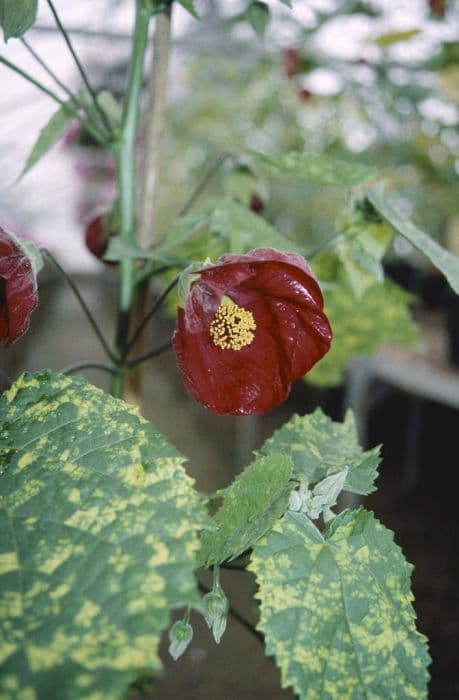
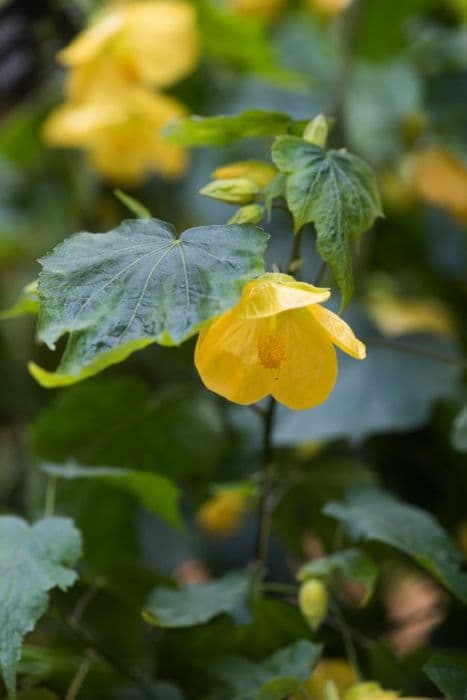
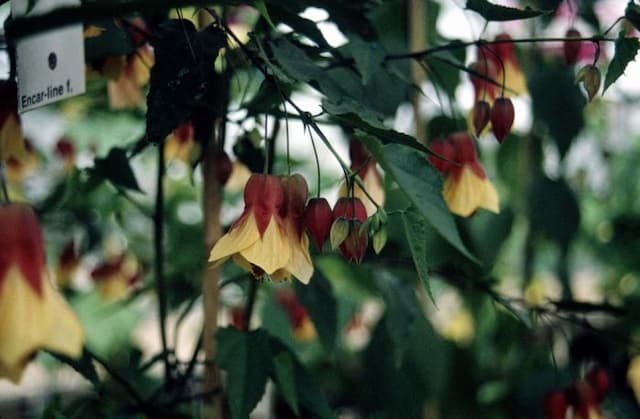
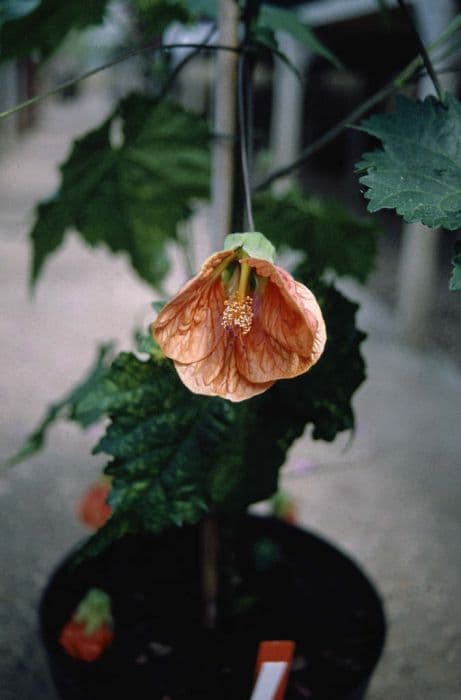
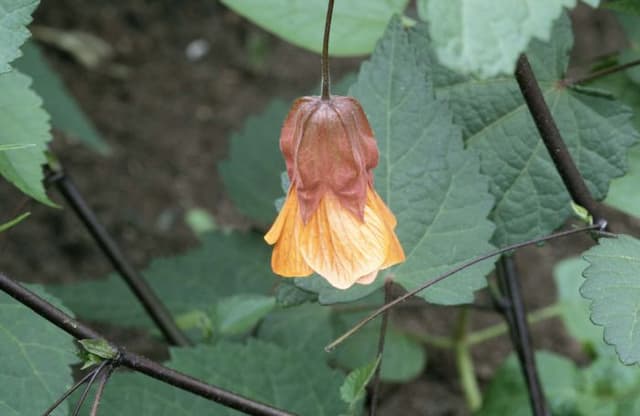
![Abutilon [Yellow Trumpet]](/_next/image?url=https%3A%2F%2Fplants-admin.emdemapps.com%2Fimages%2Fplants%2F%2Fimages%2F604b5caa8b4fb.png&w=640&q=75)


